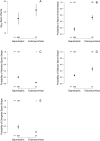Fungal spore diversity reflects substrate-specific deposition challenges
- PMID: 29599480
- PMCID: PMC5876365
- DOI: 10.1038/s41598-018-23292-8
Fungal spore diversity reflects substrate-specific deposition challenges
Abstract
Sexual spores are important for the dispersal and population dynamics of fungi. They show remarkable morphological diversity, but the underlying forces driving spore evolution are poorly known. We investigated whether trophic status and substrate associations are associated with morphology in 787 macrofungal genera. We show that both spore size and ornamentation are associated with trophic specialization, so that large and ornamented spores are more probable in ectomycorrhizal than in saprotrophic genera. This suggests that spore ornamentation facilitates attachment to arthropod vectors, which ectomycorrhizal species may need to reach lower soil layers. Elongated spore shapes are more common in saprotrophic taxa, and genera associated with above ground substrates are more likely to have allantoid (curved elongated) spores, probably to lower the risk of wash out by precipitation. Overall, our results suggest that safe arrival on specific substrates is a more important driver of evolution in spore morphology than dispersal per se.
Conflict of interest statement
The authors declare no competing interests.
Figures



Similar articles
-
Soil spore bank communities of ectomycorrhizal fungi in endangered Chinese Douglas-fir forests.Mycorrhiza. 2018 Jan;28(1):49-58. doi: 10.1007/s00572-017-0800-1. Epub 2017 Sep 23. Mycorrhiza. 2018. PMID: 28942552
-
Spore dispersal of a resupinate ectomycorrhizal fungus, Tomentella sublilacina, via soil food webs.Mycologia. 2005 Jul-Aug;97(4):762-9. doi: 10.3852/mycologia.97.4.762. Mycologia. 2005. PMID: 16457345
-
Main airborne Ascomycota spores: characterization by culture, spore morphology, ribosomal DNA sequences and enzymatic analysis.Appl Microbiol Biotechnol. 2010 Apr;86(4):1171-81. doi: 10.1007/s00253-010-2448-z. Epub 2010 Feb 9. Appl Microbiol Biotechnol. 2010. PMID: 20143229
-
Fungal cannons: explosive spore discharge in the Ascomycota.FEMS Microbiol Lett. 2007 Nov;276(1):12-8. doi: 10.1111/j.1574-6968.2007.00900.x. Epub 2007 Sep 3. FEMS Microbiol Lett. 2007. PMID: 17784861 Review.
-
Smut fungi (Basidiomycota p.p., Ascomycota p.p.) of the world. novelties, selected examples, trends.Acta Microbiol Immunol Hung. 2008 Jun;55(2):91-109. doi: 10.1556/AMicr.55.2008.2.2. Acta Microbiol Immunol Hung. 2008. PMID: 18595315 Review.
Cited by
-
When to cut your losses: Dispersal allocation in an asexual filamentous fungus in response to competition.Ecol Evol. 2019 Mar 12;9(7):4129-4137. doi: 10.1002/ece3.5041. eCollection 2019 Apr. Ecol Evol. 2019. PMID: 31015993 Free PMC article.
-
A new model for the global patterning of spores and pollen grains.Protoplasma. 2025 Aug 14. doi: 10.1007/s00709-025-02103-8. Online ahead of print. Protoplasma. 2025. PMID: 40810900
-
Natural trait variation across Saccharomycotina species.FEMS Yeast Res. 2024 Jan 9;24:foae002. doi: 10.1093/femsyr/foae002. FEMS Yeast Res. 2024. PMID: 38218591 Free PMC article. Review.
-
Climate-linked biogeography of mycorrhizal fungal spore traits.Proc Natl Acad Sci U S A. 2025 Jul 22;122(29):e2505059122. doi: 10.1073/pnas.2505059122. Epub 2025 Jul 15. Proc Natl Acad Sci U S A. 2025. PMID: 40663605
-
Placement of Triblidiaceae in Rhytismatales and comments on unique ascospore morphologies in Leotiomycetes (Fungi, Ascomycota).MycoKeys. 2019 Jun 18;54:99-133. doi: 10.3897/mycokeys.54.35697. eCollection 2019. MycoKeys. 2019. PMID: 31258376 Free PMC article.
References
-
- Ingold, C. T. Fungal spores: their liberation and dispersal. Oxford University Press (1971).
-
- Culley TM, Weller SG, Sakai AK. The evolution of wind pollination in angiosperms. Trends in Ecology and Evolution. 2002;17:361–369. doi: 10.1016/S0169-5347(02)02540-5. - DOI
-
- Kuparinen A, Markkanen T, Riikonen H, Vesala T. Modeling air-mediated dispersal of spores, pollen and seeds in forested areas. Ecological Modelling. 2007;208:177–188. doi: 10.1016/j.ecolmodel.2007.05.023. - DOI
Publication types
MeSH terms
LinkOut - more resources
Full Text Sources
Other Literature Sources

